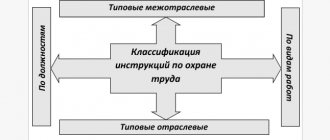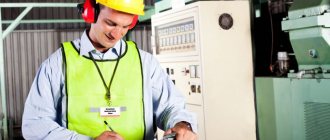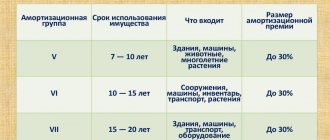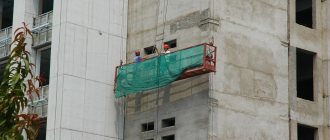Home / Labor Law / Personnel Management / Personnel training and certification
Back
Published: 08/14/2016
Reading time: 9 min
0
2753
Ensuring labor safety and eliminating factors that pose a risk to the life or health of workers is one of the main obligations of every employer. To achieve this goal, he must periodically inspect the workplaces of his subordinates and eliminate all possible risks.
The document that is drawn up is called a workplace map. Its purpose, structure and filling rules are worth considering in more detail.
- Legislation
- Purpose of the document
- What points are included in the map? Comprehensive assessment of working conditions (WC) that are present at a specific workplace (or in a group of such places)
- Injury safety assessment
- Establishment of additional benefits and compensations
Legislation
Previously, conducting workplace certification (WW) was a procedure from which some business entities (in particular, representatives of small businesses) were exempted.
But, since the beginning of 2014, this procedure has become mandatory for all employers, without exception, as established by the 2013 Russian Federation Law “On Special Assessment of Working Conditions.”
In accordance with this law, the concept of workplace certification is replaced by a special assessment of working conditions. As for the document in which the results of the procedure are entered (that is, the automated workplace card), its form is also approved by law, with the help of Order of the Ministry of Health and Social Development of Russia dated April 26, 2011 N 342n “On approval of the Procedure for certifying workplaces based on working conditions.”
Purpose of the document
An automated workplace map is drawn up for each workplace name, that is, one copy of it can be issued for several similar workplaces at once. It is a document that is designed to display basic data about the following working conditions at the enterprise:
- organization and equipment of work areas;
- assessment of workplaces;
- material support for employees (material compensation, personal protective equipment);
- Availability of benefits and special working conditions for staff.
Its preparation is necessary to achieve the following goals:
- Allocation of jobs that do not meet established criteria. If normal indicators and data obtained as a result of measurements have strong deviations from the norm, then further work at this place may be prohibited. Penalties will be imposed on the employer.
- Development of an action plan to improve working conditions. This is possible if violations identified at the workplace are subject to elimination and can be eliminated within a certain time.
- Justification of benefits and compensation provided to employees annually. If the card indicates that certain workplace conditions differ from normal, the employee may be provided with benefits, additional payments, and compensation for this. If this does not happen, the subordinate may seek protection of his interests in court or the labor inspectorate.
- Introducing new employees to future working conditions. This is especially true in situations where there are harmful or dangerous factors in the workplace. The subordinate must be familiar with such information.
The card can be intended for both external and internal use. The document must be kept completely completed and kept up to date at all times, as it protects the interests of both the employer and the employee.
When they are needed
When you need to fill out forms, it is mandatory.
| Field of activity | Rule of law | Rule |
| Fuel and energy industry | Clauses 2.8 and 2.9 of the Regulations on the procedure for briefing and training in safe techniques and methods of work at oil refining industry enterprises, approved by Order of the Ministry of Fuel and Energy of the Russian Federation No. 34 of 02.20.1995 | The form must be created for each new employee, which means that data on introductory training must be entered not only into the journal, but a separate card form must be created |
| Gas industry | Clause 1.4.13 of Intersectoral Labor Safety Rules in the Gas Industry, approved by Resolution of the Ministry of Labor of the Russian Federation No. 27 of May 12, 2003 | It is indicated that the results for all training, except the target one, must also be entered into the map |
| Culture (particularly theaters and concert halls) | Clause 1.3.4 of the Labor Safety Rules in these institutions, approved by Order of the Ministry of Culture of the Russian Federation No. 2 of 01/06/1998 | It is mandatory to reflect data on introductory and initial training in your personal card. |
This list is not exhaustive, regulations are constantly changing, and it is necessary to clarify the relevance of the rules for certain industries.
Personal occupational safety card
What points are included in the map?
The document is presented in the form of a form with the corresponding columns located on several sheets. At the very beginning, information about the employer who conducts the certification is indicated, namely:
- full name;
- address;
- Full name of the head;
- TIN;
- various codes (OKPO, OKOGU, OKVED, OKATO).
Next, enter the card number and indicate information about the employee (his profession or position). The document also contains information in several areas:
Comprehensive assessment of working conditions (WC) that are present at a specific workplace (or in a group of such places)
Each of them has its own established criteria. In particular, the following factors are subject to assessment:
- chemical;
- infrasound;
- biological;
- noise;
- vibration;
- ultrasound;
- the severity of labor;
- microclimate;
- labor intensity;
- light environment;
- ionizing radiation.
For each factor, its maximum permissible level (or concentration), actual level and duration of exposure are indicated.
Injury safety assessment
This clause must be present in the document, because the main purpose of its preparation is precisely to protect the employee from various harmful and dangerous factors.
Establishment of additional benefits and compensations
In particular, the following types are provided:
- increased wages;
- provision of annual additional leave;
- establishment of reduced working hours;
- provision of milk or other equivalent products;
- provision of therapeutic and preventive nutrition.
For each type of compensation, its actual availability is indicated, as well as the necessity and basis for its establishment.
The document also notes that the subordinate has the right to early retirement, the need for routine medical examinations and recommendations for further improvement of working conditions.
Filling rules
Detailed instructions and recommendations for filling out the document are contained in Appendix No. 3 to the Procedure for Certification of Workplaces for Working Conditions. These recommendations are given for each line of the map.
The responsibility for filling it out rests with a specially created certification commission, which includes:
- Heads of departments or divisions of the company. This category of employees belongs to the management level, so their main responsibility is to check and optimally organize workplaces.
- Lawyers. These specialists are necessary to ensure that the certification procedures and registration of the automated workplace card are carried out as correctly as possible from the point of view of legislation.
- HR workers. They can help in the correct organization of workplaces in terms of their territorial location. They also perform an organizational function: they compile a list of jobs, correct titles of positions and professions, etc.
- Labor and wages specialists, accountants. With their help, you can most accurately calculate possible additional payments and compensation allowances for employees.
- Medical workers. Their goal is to preserve the health of employees and minimize the negative impact that work environment factors have on them.
- Occupational safety specialists. These categories of workers are responsible for drawing up documentation related to their field: labor protection instructions, certification schedules, etc.
- Trade union representatives. They protect the interests of the employee and monitor compliance with labor safety rules and requirements.
- Representatives of the certifying organization. This organization has the form of a legal entity and is invited to participate in the procedure on independent terms. The presence of its representative on the commission is mandatory.
After the certification, all members of the commission put their signatures on the completed certification card form.
A sample workplace certification card form can be downloaded here.
Psychiatric examination before hiring is mandatory in a number of professions. Got sick on vacation? Do you want to apply for sick leave? Read here how to do it correctly. You can find out the competent advice and information you need on calculating maternity benefits in our article.
Workplace certification card for working conditions (example)
Certification card
workplace according to working conditions No. 1
cleaners of industrial and office premises —————————————————————————— (profession, employee position) Mirage LLC Name of organization: ——————— ———————— Russian Federation, Moscow, st. Admiral Organization address: —————————————————— Makarova, 2 ——————————————————————— —— cleaning staff Name of department: ——————————————- laboratory, bathrooms Name of area (bureau, sector): ———————————- 1 Number and numbers of similar workplaces (WM) ——————— 01 Line 010. Issue of ETKS, KS ——————————————- Line 020. Number of employees: 1 per WP ————— ——————————————— — on similar RMs —————————————————— 1 of them women ————————— —————————— Line 030. Assessment of working conditions: according to the degree of harmfulness and (or) danger of factors in the working environment —————————————————————— ——— and the labor process ——————————————————————————————————————————-T— ———————¬ ¦ Name of production factors ¦ Class of working conditions ¦ ¦ environment and labor process ¦ ¦ +————————————————+———————— + ¦Chemical ¦ 2 ¦ +———————————————+————————+ ¦Biological ¦ — ¦ +——————————— —————+————————+ ¦APFD ¦ 2 ¦ +———————T—————————+————————+ ¦Acoustic ¦Noise ¦ 2 ¦ ¦ +—————————+————————+ ¦ ¦Infrasound ¦ — ¦ ¦ +—————————+—————— ——+ ¦ ¦Air ultrasound ¦ — ¦ ¦ +—————————+————————+ ¦ ¦Contact ultrasound ¦ — ¦ +———————+——— ——————+————————+ ¦General vibration ¦ — ¦ +————————————————+————————+ ¦ Local vibration ¦ — ¦ +————————————————+————————+ ¦Non-ionizing radiation ¦ — ¦ +——————————— —————+————————+ ¦Ionizing radiation ¦ — ¦ +————————————————+————————+ ¦Microclimate ¦ 2 ¦ +————————————————+————————+ ¦Lighting ¦ 2 ¦ +—————————————— ——+————————+ ¦The severity of labor ¦ 2 ¦ +—————————————————+————————+ ¦The intensity of labor ¦ 2 ¦ +————————————————+————————+ ¦Air ion composition ¦ — ¦ +—————————————— ——+————————+ ¦General assessment of working conditions ¦ 2 ¦ L————————————————+————————- 1st grade — in terms of injury safety ———————————————— (class of working conditions in terms of injury safety) complies with - in terms of PPE provision ———————————————— (workplace complies (does not meet) the requirements for the provision of PPE, PPE is not provided)
Actual state of working conditions by factors
production environment and work process
—-T——————T———-T————T—————-T——————T——-¬ ¦ ¦ Name ¦ ¦ ¦ Actual ¦ ¦ ¦ ¦ ¦ factor ¦ ¦ ¦ factor level ¦ ¦ ¦ ¦ N ¦ production¦ Date ¦ MPC, MPL, ¦production¦ Duration¦ Class ¦ ¦ p/p¦ environment ¦ conduction¦ permissible ¦ environment ¦ influence ¦ conditions¦ ¦ ¦ and labor ¦ measurements ¦ level ¦ and labor ¦ (hours/%) ¦ labor ¦ ¦ ¦ process, ¦ ¦ ¦ process ¦ ¦ ¦ ¦ ¦ units. measurements ¦ ¦ ¦ ¦ ¦ ¦ +—+——————+———-+————+—————-+——————+——-+ ¦ 1 ¦ 2 ¦ 3 ¦ 4 ¦ 5 ¦ 6 ¦ 7 ¦ +—+——————+———-+————+—————-+——————+——-+ ¦ 1 ¦ Temperature ¦ February ¦ 17 - 23/ ¦ 22/24 ¦ 480 ¦ 2 ¦ ¦ ¦ air, °C ¦ ¦ 18 - 27 ¦ ¦ ¦ ¦ +—+——————+———-+—— ——+—————-+——————+——-+ ¦ 2 ¦ Speed ¦ April ¦ 0.1 - 0.4 ¦ 0 ¦ 480 ¦ 1 ¦ ¦ ¦ movements ¦ 2009 ¦ ¦ ¦ ¦ ¦ ¦ ¦ air, m/s ¦ ¦ ¦ ¦ ¦ ¦ +—+——————+———-+————+—————-+—————— +——-+ ¦ 3 ¦ Humidity ¦ — ¦ 15 — 75 ¦ 47/52 ¦ 480 ¦ 2 ¦ ¦ ¦ air, % ¦ ¦ ¦ ¦ ¦ ¦ +—+——————+———-+ ————+—————-+——————+——-+ ¦ 4 ¦ Natural ¦ — ¦ Absent/¦ Absent/0.6¦ 480 ¦ — ¦ ¦ ¦ lighting, KEO, % ¦ ¦ 0.6 ¦ ¦ ¦ ¦ +—+——————+———-+————+—————-+——————+——-+ ¦ 5 ¦ Illumination, lux¦ — ¦ 75 ¦ 100 — 180 ¦ 480 ¦ 2 ¦ +—+——————+———-+————+—————-+——————+ ——-+ ¦ 6 ¦ Noise, dBA ¦ — ¦ 60 ¦ 50 — 55 ¦ 480 ¦ 2 ¦ +—+——————+———-+————+—————-+ ——————+——-+ ¦ 7 ¦ Chlorine, mg/cub. m ¦ — ¦ 1.0 ¦ No limit ¦ 480 ¦ 1 ¦ ¦ ¦ ¦ ¦ ¦ detections ¦ ¦ ¦ +—+——————+———-+————+—————- +——————+——-+ ¦ 8 ¦ Ammonia, mg/ ¦ — ¦ 20.0 ¦ No limit ¦ 480 ¦ 1 ¦ ¦ ¦ cubic. m ¦ ¦ ¦ detections ¦ ¦ ¦ +—+——————+———-+————+—————-+——————+——-+ ¦ 9 ¦ Dust ¦ — ¦ 4.0 — 6.0 ¦ 3.0 — 4.0 ¦ 480 ¦ 2 ¦ ¦ ¦production,¦ ¦ ¦ ¦ ¦ ¦ ¦ ¦ mg/cub. m ¦ ¦ ¦ ¦ ¦ ¦ +—+——————+———-+————+—————-+——————+——-+ ¦ The severity of the labor process ¦ +—T——————T———-T————T—————-T——————T——-+ ¦ 10¦ Raise ¦ — ¦ up to 10 ¦ Up to 10 ¦ 480 ¦ 2 ¦ ¦ ¦ and moving ¦ ¦ ¦ ¦ ¦ ¦ ¦ ¦ ¦ ¦ ¦ ¦ ¦ ¦ ¦ ¦ when alternating ¦ ¦ ¦ ¦ ¦ ¦ ¦ ¦ with other work,¦ ¦ ¦ ¦ ¦ ¦ ¦ ¦ kg ¦ ¦ ¦ ¦ ¦ ¦ +—+——————+———-+————+—————-+——————+——-+ ¦ 11¦ Body tilts,¦ — ¦ 51 — 100 ¦ Up to 50 ¦ 480 ¦ 2 ¦ ¦ ¦ quantity per shift ¦ ¦ ¦ ¦ ¦ ¦ +—+——————+———-+————+———— —-+——————+——-+ ¦ 12¦ Tension ¦ — ¦ 6 ¦ 1 ¦ 480 ¦ 2 ¦ ¦ ¦ labor ¦ ¦ ¦ ¦ ¦ ¦ ¦ ¦ ¦ ¦ ¦ ¦ ¦ ¦ ¦ ¦ show ¦ ¦ ¦ ¦ ¦ ¦ +—+——————+———-+————+—————-+——————+——-+ ¦ (work according to a series of instructions ) ¦ +—T——————T———-T————T—————-T——————T——-+ ¦ ¦ ¦ ¦ ¦ ¦ ¦ L— +——————+———-+————+—————-+——————+———
Line 040. Guarantees and compensation for employees engaged in heavy work, work with harmful and (or) dangerous working conditions
—-T—————————T————T—————————-¬ ¦ ¦ ¦ Actual¦ Based on the results of assessment ¦ ¦ ¦ ¦ ¦ working conditions ¦ ¦ N ¦ Type of guarantees and compensations+————+—————T————-+ ¦p/p¦ ¦ availability ¦ necessity¦ ¦ ¦ ¦ ¦ and size ¦ and size ¦ basis ¦ ¦ ¦ ¦ compensations¦ compensations ¦ ¦ +—+—————————+————+—————+————-+ ¦ 1 ¦Amount of increase in pay ¦ — ¦ — ¦ ¦ ¦ ¦workers’ labor in % ¦ ¦ ¦ ¦ ¦ ¦ (factors that determine it) ¦ ¦ ¦ ¦ +—+—————————+————+—————+————-+ ¦ 2 ¦Additional leave ¦ — ¦ — ¦ ¦ ¦ ¦(working days) ¦ ¦ ¦ ¦ +—+—————————+————+—————+————- + ¦ 3 ¦Working duration ¦ 40 ¦ 40 ¦st. 91 Labor Code of the Russian Federation,¦ ¦ ¦weeks (hour) ¦ ¦ ¦ (Federal¦ ¦ ¦ ¦ ¦ ¦ law ¦ ¦ ¦ ¦ ¦ ¦ N 197-FZ) ¦ +—+————————+—— ——+—————+————-+ ¦ 4 ¦Milk or other ¦ — ¦ — ¦ ¦ ¦ ¦equivalent food ¦ ¦ ¦ ¦ ¦ ¦products ¦ ¦ ¦ ¦ +—+————— ————+————+—————+————-+ ¦ 5 ¦Therapeutic and preventive ¦ — ¦ — ¦ ¦ ¦ ¦nutrition ¦ ¦ ¦ ¦ +—+—————— ———+————+—————+————-+ ¦ 6 ¦Early appointment ¦ no ¦ — ¦ ¦ ¦ ¦ labor pension ¦ ¦ ¦ ¦ ¦ ¦ old age ¦ ¦ ¦ ¦ L— +—————————+————+—————+—————
Line 050. Frequency of medical examinations:
———————————T——————————————— ¦ Actual ¦ Recommended based on assessment results ¦ ¦ ¦ working conditions ¦ +—— ——-T——————+——————-T———————+ ¦periodicity¦ basis ¦ periodicity ¦ basis ¦ +————-+——————+ ——————-+———————+ ¦ 1 time ¦List of positions¦ Upon admission ¦ Art. 213 of the Labor Code of the Russian Federation ¦ ¦ in 2 years ¦ and professions ¦ for work 1 time ¦ (Federal Law ¦ ¦ ¦ subject ¦ in 2 years ¦ from 12/30/2001 ¦ ¦ ¦ preliminary ¦ ¦ N 197-FZ), Order ¦ ¦ ¦ and periodic ¦ ¦ Ministry of Health and Social Development ¦ ¦ ¦ medical examinations ¦ ¦ Russia dated 08/16/2004¦ ¦ ¦ from “__” _______ ¦ ¦ N 83 ¦ ¦ ¦ 200_ ¦ ¦ ¦ L————-+—————— +——————-+———————- Line 060. Recommended work and rest schedules: a) regulated breaks (number, duration) according to the Internal Labor Regulations ________________________ no b) other recommendations ———— ———————————— Line 070. Recommendations for the selection of workers: possibility of using labor: yes a) women ————————————————————- except work on cleaning bathrooms b) persons under the age of 18 ——————————————- no c) other recommendations ———————————————— Line 080 Recommendations for improving working conditions, the need for additional research: — —————————————————————————— Line 090. Conclusion of the certification commission. The workplace is certified: class 2 for factors of the working environment and labor process ————— (1, 2, 3.1, 3.2, 3.3, 3.4, 4) class 1 for injury safety ————————————— ———- (1, 2, 3) corresponds to the availability of PPE ————————————————- (meets (does not meet) the requirements for the availability of PPE, PPE is not provided) Chairman of the certification commission Pirogov V.A. deputy Director _____________ ———— ————— ___________ (signature) (full name) (position) (date) Members of the certification commission Stupin V.A. chief engineer _____________ ———— ———————— ___________ (signature) (full name) (position) (date) Volkov N.I. labor safety engineer _____________ ———— ———————— ___________ (signature) (full name) (position) (date) Pylaev A.V. head of laboratory AWP _____________ ————- ———————— ___________ (signature) (Full name) (position) (date) Shpankov S.S. laboratory specialist AWP _____________ ————- ———————— ___________ (signature) (Full name) (position) (date) Morozova O.P. Head of HR Department _____________ ————- ———————— ___________ (signature) (Full name) (position) (date)








